Electric travelling cranes & Electric Power Supply System
Electric travelling Crane
An electric overhead traveling crane, or EOT crane, is a type of overhead crane that has parallel runways with a traveling bridge spanning the gap. These cranes are powered by electricity. There are several types of EOT cranes, including single girder cranes, double girder bridge cranes, and gantry cranes. Single girder cranes have a single bridge girder supported by two end trucks, while double girder bridge cranes have two bridge girders supported by two end trucks on each side of the crane. Gantry cranes are similar to regular overhead cranes, but the bridge that carries the trolley or trolleys is rigidly supported on two or more legs that run on fixed rails or other runways.
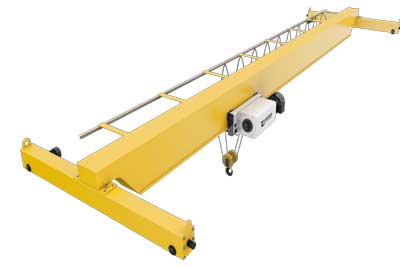 electric overhead cranes
electric overhead cranes
The electrification system is one of the most important elements of a crane and hoisting system. The electrification system at a minimum will provide a single or three-phase power supply required by the traveling crane and hoist equipment, but may also carry control signals that operate contactors, limit switches, and other functions. With the many different types and brands of electrification being available, it can be difficult for a user to determine which electrification system is best is a specific application.
The electrification system is a crucial component of a crane and hoisting system. It provides the power supply needed for the crane and hoist equipment to operate, and may also transmit control signals for various functions. With so many different types and brands of electrification systems available, it can be challenging for users to determine the best one for their specific needs.
Types of electric power systems for your cranes
Overhead crane power rails or monorail electrification systems are made up of conductor bars, cable festoon systems, cable reels, or energy chains. These components are mounted on the runway and provide the mainline power along the length of the runway or monorail track.
Conductor Bar
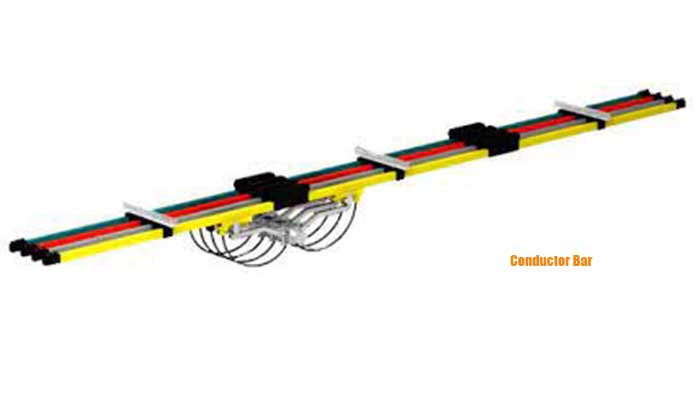
Conductor bars, also known as power bars, figure eight bars or hot bars, are a common method of providing power to cranes and hoists. They are made of galvanized steel, copper, or stainless steel, depending on the application and amperage requirement. The conductor bar is typically covered with a nonconductive plastic cover on three sides, with an opening for the collector shoe that transfers power from the mainline to the bridge or trolley. Conductor bars can be suspended from brackets on the runway structure or bridge, or mounted flush to the web of the runway or bridge beam. For three-phase power, 3 individual conductors are used for phased power and one for a ground. The ground bar must have a different color cover (usually green) than the power conductors.
In longer systems, expansion assemblies are used to keep the bar straight when temperatures change dramatically and multiple power feeds may be needed to reduce amperage drop. The main maintenance areas for conductor bar systems are the collector assemblies and shoes, as they are subject to normal wear and tear.
Advantages of conductor bars:
- No length restrictions
- Runway systems can be easily extended
- Low cost in standard applications
- Easy to install
- Low maintenance
- Can be used on runways with multiple bridges
Disadvantages of conductor bars:
- Collector shoes can wear out quickly
- Opening at the bottom can create a potential shock hazard
- Cannot be used in explosive environments
Festoon System
A festoon electrification system uses flat or round cable on a trolley that travels on a C track, square rail, or I-beam. This method of overhead crane power rail provides direct contact, resulting in greater resistance to wear on the system's components. Festoon cables are typically flat cables with multiple conductors to match the number of conductors required for the application. Multiple cables are stacked to separate power and control currents. The ultimate length of a festoon system is limited by the loop depth used, required wire size, and space limitation of the festoon trolley stack-up on the fixed end. Festoon systems are economical, can be very heavy duty, and are ideal for carrying many control signals simultaneously. They are the standard electrification system used across the girder of a bridge crane and are often used for monorails and jib crane applications. Festoon systems are a good solution for power rail in hazardous environments where open conductors are not an option.
Festoon electrification systems are commonly used on bridge cranes, but can also be found on other types of overhead cranes such as gantry cranes, some monorail cranes, and jib cranes. However, certain types of festoon track may not be suitable for monorail setups with curves in the rail.
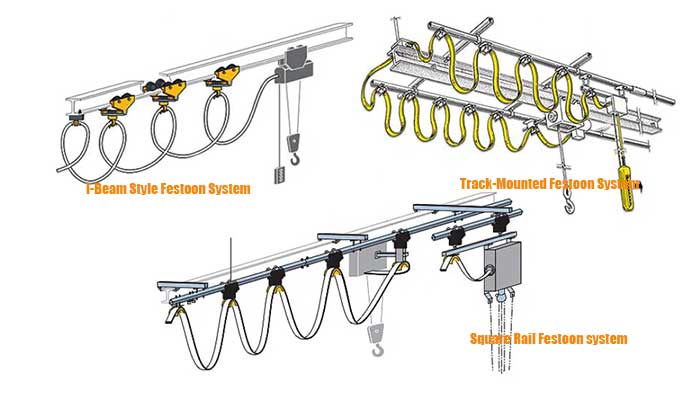
A. I-Beam Cable Festoon Systems
Festoon electrification systems are ideal for medium to high-duty applications and environments. They are available in different carrier options, from basic economic versions to custom-designed systems. These systems are easy to maintain, highly reliable, and can be pre-assembled for easier installation. Festoon systems can be configured as a basic economical design or fully customized for specialized systems. They are built for demanding environments such as steel mills, plants, and ship-to-shore cranes, and are simple to install and low-maintenance.
Track-Mounted Cable Festoon Systems for Electric Cranes
Festoon electrification systems provide effective cable management for light to medium-duty applications. Track-mounted systems allow for the organization and movement of cables and/or hoses for power and control circuits. These systems are reliable, efficient, easy to install, and have low maintenance requirements. The track material can be made of galvanized, stainless, or PVC materials for use in corrosive environments. Festoon systems can be used indoors or outdoors in dusty, dirty, or corrosive environments, as well as in high-temperature environments and applications that require an explosion-proof design.
Square Rail Festoon Systems run on a square or diamond-shaped track. This type of track is particularly useful in dirty or dusty environments and can be used indoors or outdoors, including in applications that require an explosion-proof design. Square Rail Festoon Systems are perfect for monorail cranes as they can be configured to work on straight, curved, or circular tracks.
Advantages of Square Rail Festoon Systems:
- Relatively low cost
- Easy to install
- Easy to maintain
- Can be used in corrosive and explosion-proof applications
Disadvantages of Square Rail Festoon Systems:
- Not ideal for use on runways with multiple bridges
- Ultimate length is limited by wire size and festoon stack-up capability
- Environmental considerations must be taken into account when selecting the right material for the cable and cable sheath
Cable Reel
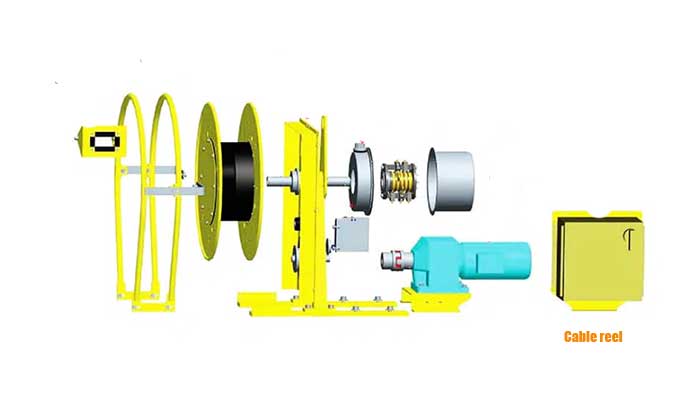
A cable reel is an electrical cord that pays out and retracts into a spring-loaded reel. Cable reels are useful for shorter power and control applications when a festoon system is not feasible due to potential interference with equipment. They may also be the best option for short monorail systems with curves and switches where open conductors are not allowed, provided that the cord can travel freely with the hoist without encountering obstructions.
Cable reels have a simple design that automatically winds and stores flexible cables. They require little to no maintenance, are easy to install, and can be mounted stationary or on a swivel base to allow the cable to payout in multiple angles and directions.
Advantages of cable reels:
Can be used in horizontal and vertical applications to provide power and control to cranes, hoists, and devices suspended on the hoist hook
Totally enclosed conductor reduces the risk of shock
Suitable for hazardous or wet environments
Disadvantages of cable reels:
Limited travel length
Maintenance issues with high use
Relatively high cost compared to festoon and conductor bar systems
Energy chain
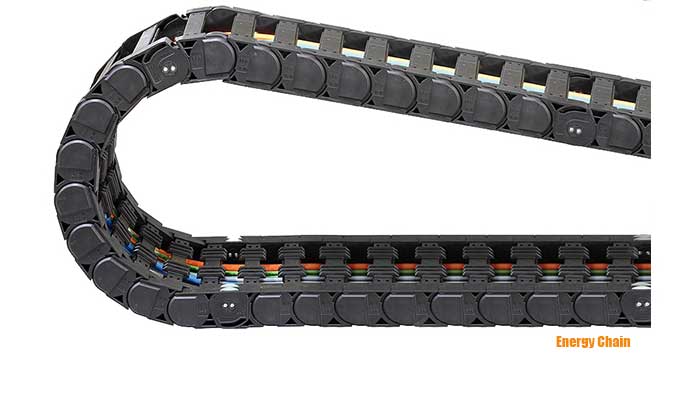
An energy chain is designed for optimal efficiency in crane electrification and overhead crane power rails. Cables are securely guided within the system using interior separators, preventing them from crossing over and becoming tangled. Cables are tightly clamped for strain relief and can be easily and individually released for repair or replacement. Unlike festoon systems, where an entire composite cable may need to be replaced if one conductor is damaged, with energy chains, only the damaged cable needs to be replaced. A center-mounted energy chain system requires approximately 50% less cable than a festoon system, reducing mechanical stress, system weight, and acquisition costs. The absence of hanging loops also means that the required operating window is considerably smaller than with festoon systems, making energy chains a good choice for applications with restricted space. Energy chains can power overhead cranes in harsh environmental conditions without damaging the cables.
Installation of an energy chain is simple. A guide trough is installed on the crane girder, the energy chain is populated with cables, and then installed into the trough. The moving end is attached to the trolley and the cables are routed to their connection points. Energy chains can even be pre-populated with cables by the manufacturer, making installation even more straightforward. Energy chains can accommodate horizontal, vertical, rotary, and three-dimensional movements. Unlike festoon systems, which require maintenance such as lubrication or replacement of worn wheels, shock cords, and bearings, energy chains are maintenance-free and only require basic visual inspections to ensure they are in good working order.
Energy chains are engineered to protect cables from debris and extreme weather conditions. Their clean and durable design allows them to withstand demanding environments. Wind is not a problem for energy chains, as cables are securely guided and cannot get caught. The predefined bending radius also prevents cables from being bent below the manufacturer's recommended bend radius, which can sometimes occur with free-hanging festoons. For additional protection, energy chains are available with integrated rollers for extremely long travel distances and special materials for chemical resistance. The rugged energy chain can be configured in many different ways to meet the needs of a wide variety of applications, including outdoor gantry cranes and indoor bridge cranes.
Advantages of energy chains:
- Easy to install
- Virtually maintenance-free
- Corrosion and wear-resistant features
Disadvantages of energy chains:
- High cost
- Not recommended for push-button control cranes
Q: What are the different types of electric cranes?
A: There are various types of electric overhead traveling cranes, including single girder cranes, double girder bridge cranes, and gantry cranes. Single girder cranes consist of a single bridge girder supported on two end trucks, while double girder bridge cranes have two bridge girders supported by two end trucks on each side of the crane. Gantry cranes are similar to regular overhead cranes, except that the bridge for carrying the trolley or trolleys is rigidly supported on two or more legs running on fixed rails or other runways.
Q: What is the power supply voltage for electric cranes?
A: According to OSHA regulations, the control circuit voltage for an electric overhead crane or electric gantry crane shall not exceed 600 volts for a.c. or d.c. current. The voltage at pendant push-buttons shall not exceed 150 volts for a.c. and 300 volts for d.c.
Q: What is the lifting capacity of electric cranes?
A: The lifting capacity of an electric crane varies depending on its type, size, and design. It's important to consult the manufacturer's specifications to determine the maximum lifting capacity of a specific crane.
Q: What safety features do electric cranes have?
A: Electric cranes are equipped with various safety features to protect operators and workers, such as overload protection, emergency stop buttons, anti-collision devices, and warning lights and alarms. It's important to follow all safety guidelines and regulations when operating an electric crane.
Q: What are the maintenance requirements for electric cranes?
A: Regular maintenance is essential to ensure the safe and efficient operation of an electric crane. Maintenance tasks may include inspecting and lubricating moving parts, checking electrical components and connections, and testing safety devices. It's important to follow the manufacturer's recommended maintenance schedule and guidelines.




